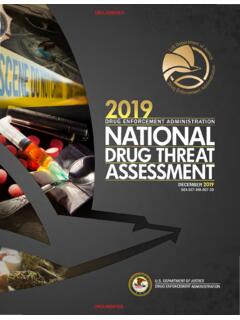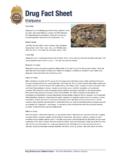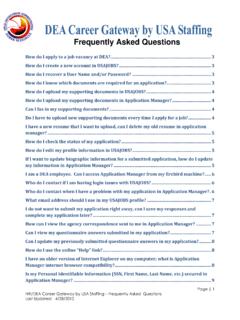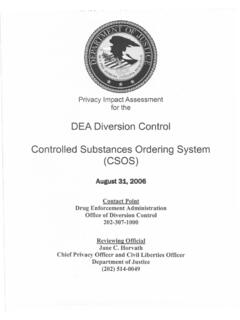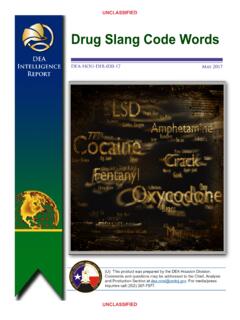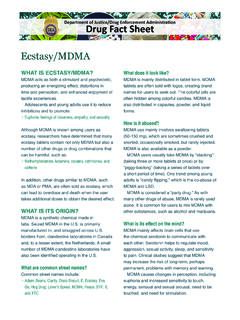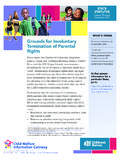Transcription of The Drug Enforcement Administration (DEA) 1980-1985
1 DRUG Enforcement Administration History 1980-1985 During the early 1980s, international drug trafficking orga-nizations reorganized and began operating on an unprecedented scale. The rise of the Medellin cartel, the influx of cocaine into the , and the violence associated with drug trafficking and drug use complicate the task of law Enforcement at all levels. Violent crime rates rose dramatically during this period and continued to rise until the early 1990s.
2 The normalization of drug use during the previous two decades continued as the population rediscovered cocaine. Many saw cocaine as a benign, recreational drug. In 1981, Time magazine ran a cover story en-titled, High on Cocaine with cover art of an elegant martini glass filled with cocaine. The article reported that cocaine s use was spreading quickly into America s middle class: is the drug of choice for perhaps millions of solid, conven-tional and often upwardly mobile citizens.
3 Drug abuse among citizens in the early 1980s remained at dangerously high levels. The 1980 arrest of Leroy Butler, one of the most significant heroin traffickers in New York City, also led to the seizure of the $40,000 Rolls Royce shown here. Posing with the cars are, from left: SA Lewis Rice, SA Thor Nowozeniuk, and GS Fred Gormandy 49 History Members of the Mexico City Management Team, June 1980, back row, left to right: CA Rudy Ramirez, Costa Rica CO; RAC Richard Canas, Monterey RO; RAC Ruben Salinas, Mazatlan RO; CA Guatemala; RAC William Rochon, Guadalajara RO; RAC William Farnan, Merida RO; and RAC Thomas Telles, Hermosillo RO.
4 Front row: GS Charlie Lugo; Mexico City Asst. Regional Director Frank Macolini, Mexico City; DEA Administrator Peter Bensinger; Regional Director Edward Heath, Mexico City; and GS Frank Cruz, Mexico City. The Rise of the Medellin Cartel By the early 1980s, the drug lords of the Medellin cartel were well established in Colombia, where they used murder, intimida tion, and assassination to keep journalists and public officials from speaking out against them. Law Enforcement officers and judges were favored targets of these brutish drug cartels that controlled entire towns and economies to support their criminal business.
5 By 1985, Colombia had the highest murder rate in the world. In Medellin alone, 1,698 people were murdered, and the follow ing year, that number more than doubled to 3,500. The Medellin cartel was fast becoming the richest and most feared underworld crime syndicate the world had ever encountered. During the period 1980 through 1985, the Medellin mafias delivered to the a large measure of the wholesale violence and terror that their drug trafficking activities had inflicted on their home country.
6 In a grim parody of their campaign to control Colombia, they insinuated themselves into legitimate, and useful, sectors of the economy, such as the banking and import in dustries. The suffered badly from the cartel s presence as local drug gangs began to form, communities were terrorized, and drug use among teens continued to climb. Colombian Marijuana Colombian marijuana continued to be a problem in the early 1980s as Colombia-based traffickers brought boatloads of high-potency marijuana to the shores of the Consequently, the DEA ran several investigations targeting these smugglers, includ ing Operations Grouper and Tiburon.
7 In 1981, Operation Grouper was conducted in cooperation with the Coast Guard and 21 other federal, state, and local government agencies. It was one of the largest Enforcement opera tions launched against marijuana traffickers from Colombia. The operation targeted 14 separate florida , Louisiana, and Geor gia-based trafficking organiza tions that were smuggling large-scale, multi-ton quantities of marijuana and millions of dos age units of methaqualone into the For 22 months, nine DEA special agents operated undercover, some posing as off-loaders to a number of smug gling organizations.
8 The smug gling network had negotiated deliveries to states as far away as Maine and New York. As a result of the operation, agents ultimately arrested 122 out of the 155 indicted subjects, and seized more than $1 billion worth of drugs, and $12 mil lion worth of assets, including 30 vessels, two airplanes, and $1 million in cash. The following year, DEA concluded Operation Tibu ron, another major operation targeting marijuana smuggling from Colombia.
9 Tiburon resulted in the arrest of 495 people and the seizure of 95 vessels, million pounds of marijuana in the , and million pounds of marijuana in Colombia. At torney General William French Smith praised this operation as a classic example of how agencies, and indeed entire governments, can work together sharing intelligence and expertise and zeroing in on the sea and air routes used by major smugglers. Operation Swordfish (1980) In December 1980, DEA launched a major investigation in Miami aimed against international drug organizations.
10 The op eration was dubbed Operation Swordfish because it was intended to snare the big fish in the drug trade. DEA set up a bogus money laundering operation in suburban Miami Lakes that was called Dean International Investments, Inc. DEA agents teamed up with a Cuban exile who had fallen on hard times and was will ing to lure Colombian traffickers to the bogus bank. In addition to spending time in Cuban prisons after the Bay of Pigs invasion, the exile had also served jail time in the for tax fraud and was heavily in debt to the Internal Revenue Service.
